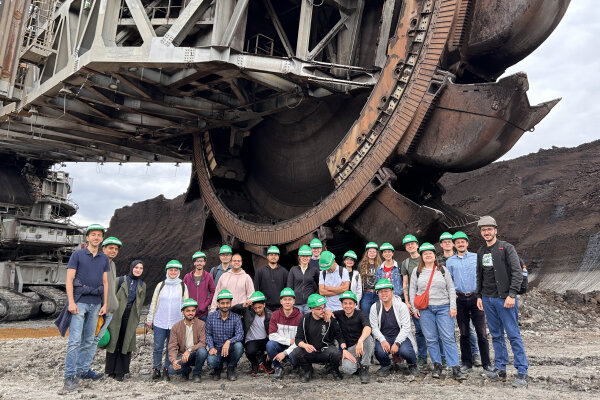25.07.2023

The Chair of Soil Mechanics, Foundation Engineering and Environmental Geotechnics organized an excursion to the opencast mine Hambach on 25 July. In addition to the students of the Subsurface Engineering programme, some Master's students of Civil Engineering took part, as well as doctoral students of the chair.
Before literally going into the opencast mine, the excursion participants met at Paffendorf Castle to hear a lecture at RWE's conference and event centre. The lecture addressed several topics starting with the basic operations of opencast mining in the Lower Rhine Bay area up to the comprehensive renaturation measures which take place at the end of the mining operations. After ending all mining operation in the Rhineland area, the three opencast mines Hambach, Garzweiler and Inden are to be filled with water in order to be converted into lakes. Dr.-Ing. Oscar Juarez, an expert in the field of geomechanics at RWE Power AG, explained the challenges to be expected. Special attention is paid to the design of the bank and slope areas of the future lakes. The groundwater level must be regulated continuously during the filling process and the slope geometry needs to be dimensioned taking into consideration that expected waves do not affect the stability.
After a short break, the group boarded an RWE off-road bus to drive into the pit. Led by Oscar Juarez, several spots could be visited not only to get an idea of the size of the pit, but also to see the different stages of production at the mine. Starting with the excavation of the upper layers of soil on one side of the open pit up to the exposure and extraction of the lignite at the deepest point of the pit, which lies around 275 meters under the sea level (400 meters below the surrounding surface level) . From this point the lignite is transported along the numerous conveyor belts to the coal bunker, where it can be loaded directly on trains that supply the surrounding power plants.
Thank you, RWE, for the opportunity to visit the mine on site.
Below you can see some impressions of the excursion.

The Chair of Soil Mechanics, Foundation Engineering and Environmental Geotechnics organized an excursion to the opencast mine Hambach on 25 July. In addition to the students of the Subsurface Engineering programme, some Master's students of Civil Engineering took part, as well as doctoral students of the chair.
Before literally going into the opencast mine, the excursion participants met at Paffendorf Castle to hear a lecture at RWE's conference and event centre. The lecture addressed several topics starting with the basic operations of opencast mining in the Lower Rhine Bay area up to the comprehensive renaturation measures which take place at the end of the mining operations. After ending all mining operation in the Rhineland area, the three opencast mines Hambach, Garzweiler and Inden are to be filled with water in order to be converted into lakes. Dr.-Ing. Oscar Juarez, an expert in the field of geomechanics at RWE Power AG, explained the challenges to be expected. Special attention is paid to the design of the bank and slope areas of the future lakes. The groundwater level must be regulated continuously during the filling process and the slope geometry needs to be dimensioned taking into consideration that expected waves do not affect the stability.
After a short break, the group boarded an RWE off-road bus to drive into the pit. Led by Oscar Juarez, several spots could be visited not only to get an idea of the size of the pit, but also to see the different stages of production at the mine. Starting with the excavation of the upper layers of soil on one side of the open pit up to the exposure and extraction of the lignite at the deepest point of the pit, which lies around 275 meters under the sea level (400 meters below the surrounding surface level) . From this point the lignite is transported along the numerous conveyor belts to the coal bunker, where it can be loaded directly on trains that supply the surrounding power plants.
Thank you, RWE, for the opportunity to visit the mine on site.
Below you can see some impressions of the excursion.